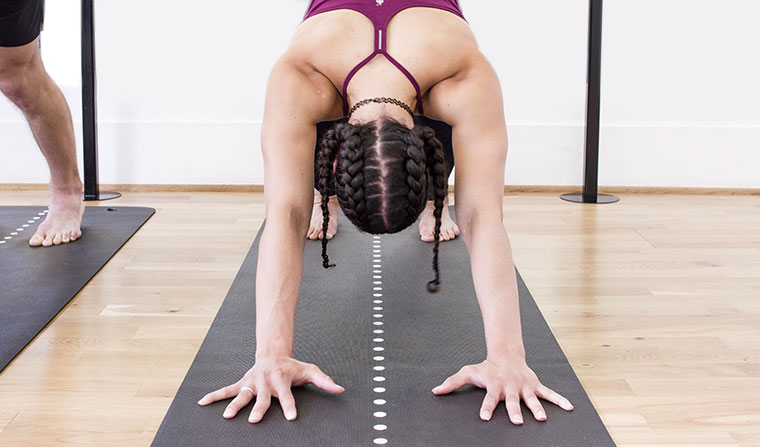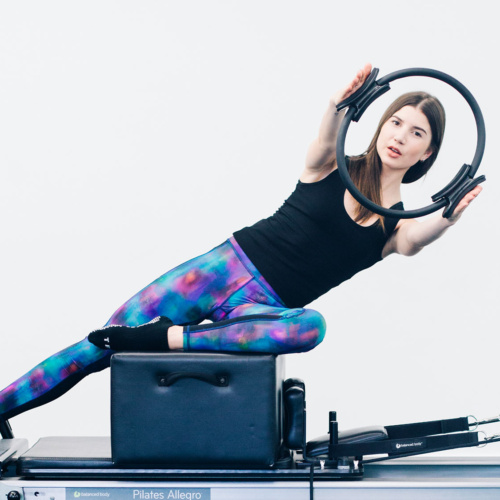Wrist pain is one of the most common complaints for beginners to yoga. In this article we’ll take a look at potential causes of wrist pain and ways to prevent it. You’ll also find some simple exercises to strengthen and stretch this small joint to keep your wrists and healthy so you can get the most out of your Yoga practice.
In dynamic styles of yoga there are several repetitive poses that involve weight bearing through the hands, which isn’t something we often do in our daily activities.
The act of bearing weight here also involves a deep extension of the wrist. In poses like all fours and plank, for example, we have the maximum extension through the joint, at a 90 degree angle between the hand and the forearm. This can be very demanding on joints that haven’t moved this far in a long time, and start to lose their natural range of motion. This in itself can make certain asanas (yoga postures) uncomfortable and sometimes painful.
Often, the pain isn’t just caused by tight wrists, but by weak ones too.
In most yoga beginners, the arms and shoulders are weak too. Because of this weakness, there is a tendency to overload the outer edge of the hand with weight: the pinkie side of the hand takes too much weight and the knuckle at the base of the index finger lifts. New yoga practitioners also often let the weight collapse into the heel of the hand, which puts too much pressure on the wrists joint. This is a recipe for sore wrists if not corrected.

As a yoga teacher, this is something I stress regularly and always check my student’s hand placement. It’s essential for the health of the wrists to be very aware of the weight distribution into the hands.
So what is the correct hand placement?
When bearing weight into the hands we must remember to spread the fingers apart, distribute the weight through the entire surface of the hand with every finger pad pressing down, and the knuckles at the base of the fingers pressing into the floor, especially grounding the index finger knuckle.
As you move from pose to pose, remember to check your hand placement. Do this until the correct alignment becomes second nature.
Maintaining the correct alignment prevents wrist injuries. We should also remember that our wrists aren’t used to bearing all this weight, so if they feel over worked or strained during the practice we should respect that and modify.
How do I modify my practice when wrists are tired or sore?
If your wrists are in pain, there isn’t much to gain from ignoring the sensations and carrying on.
Instead, continue your practice adopting some simple modifications.
If your wrists are particularly tight, try taking the hands slightly in front of the shoulders, rather than directly under the shoulders, in positions like plank and all fours. If that isn’t enough, make fists with the hands or lower on your forearms.
If downward dog becomes uncomfortable you can skip it. Rest in child’s pose instead or lower the forearms to the floor instead, into dolphin pose.
Skip all arm balances where the body weight is fully on the hands (like crow pose and handstand) until your wrists are strong and flexible enough. If crow pose is part of the flow, modify it by doing a seated yogis squat with hands in prayer and elbows gently pressing into the inner knees. Broaden the front of the chest and lengthen the spine.
You should still be able to do your practice, without loading your wrists.
If you’re not sure how to modify certain poses, ask your teacher. Ensure you speak to the teacher before class so they can explain the modifications, and see if they work for you.
Simple exercises to strengthen and stretch the wrists
If your wrists are injured or weak they need to be strengthened and stretched before you can safely bear weight.
1. Wrist curls to strengthen
As the name might suggest these are very similar to a biceps curl, but with little or no weight. Make a fist with the hand and curl the hand in toward the forearm. Another good way to build strength into the wrists is by squeezing a stress ball.
2. Heart centre stretch
To stretch the wrists take the hands in prayer at the heart centre. Press the palms into each other and gently draw the hands down, without letting the palms separate.
Always remember that yoga is meant to be beneficial and healing, so avoid straining the wrists and be patient. With time your wrists will become strong and flexible enough to support you into a wide range of yoga poses.
Even if you need to skip some poses, you’ll continue working on building strength and flexibility in other parts of the body, which may help reduce the load into the wrists with time. For instance, a strong core and strong arms also play a part in ensuring we don’t collapse the weight into the wrists when the hands are on the floor.
As always with any pain, if wrist pain is persistent and/or severe, speak to a medical professional. If you’re based in London you can book an appointment to see a Ten Physiotherapist who will help you understand and address the underlying causes and ease any symptoms to help you move with more freedom and less pain in your practice.




